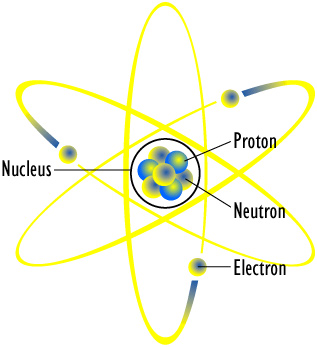 Source: Aton Diagram, Magnus Manske, Wikimedia Commons
Source: Aton Diagram, Magnus Manske, Wikimedia Commons
The nucleus of any atom larger than hydrogen is a tightly packed ball of protons and neutrons which is surrounded by electrons in various energy levels. The electric attraction between the positive protons and negative electrons keep the electrons from simply leaving the atom completely. The problem is, as we learned in lesson 3 of this module, like charges repel each other. This means that the protons in the nucleus should push each other away, and the nucleus should fall apart.
This puzzle of "how does a nucleus stay together?" led to the discovery of two nuclear forces.
 Source: Aton Diagram, Magnus Manske, Wikimedia Commons
Source: Aton Diagram, Magnus Manske, Wikimedia Commons
The Strong Nuclear Force (also referred to as the strong force) the strongest of what are now understood to be the four fundamental forces of nature. The trade-off, however, is that it also has the shortest range, meaning that particles must be extremely close before its effects are felt. The strong force is an attraction that holds protons and neutrons together. It is about 100 times stronger than the electric repulsion that the protons exert on each other, but it can only act at distances of a few femtometers (one femtometer is 1*10-15 or 0.000000000000001 meters) To put this in perspective, the approximate radius on a proton is about 0.85 femtometers. This means that each proton or neutron is only pulling with the strong force on the protons and neutrons immediately surrounding it.
The net result of this short range is that the larger the nucleus, the more likely the electric repulsion is to overcome the strong attraction, and cause the nucleus to break down. Neutrons tend to help hold a nucleus together because they add to the overall strong attraction, but do not add to the electric repulsion. On the other hand, neutrons also make the nucleus larger which–as mentioned above–can make the nucleus more likely to fall apart. In the end, the ideal number of neutrons to help hold a nucleus together is different for each element. This is why you will see stable and unstable isotopes of the same element.
The Weak Nuclear Force (also referred to as the weak interaction) is associated with the stability of a radioactive–or unstable–nucleus. It is responsible for some types of radioactive decay.